Sales Process: Building Repeatable Steps for Scalable Growth
Casey O'Connor
Any sales team that wants to consistently meet and exceed their sales goals needs to implement, track, and continuously optimize a collaborative and structured sales process.
A sales process provides consistency for both salespeople and prospects. It gives reps tangible strategies for approaching prospects at any stage of the pipeline, and it helps provide buyers with a reliable, personalized, and value-driven buying process.
Sales processes also help make growth and success more scalable.
In this article, we’ll go over everything you need to know about improving your sales process for 2023 (or, building one from the ground up if you don’t already have one in place).
Here’s what we’ll cover:
- What Is a Sales Process?
- Sales Process vs. Sales Methodology
- Sales Process Steps
- How to Build a Strong Sales Process
- How to Measure the Success of Your Sales Process
- How to Improve Your Sales Process
- Common Sales Process Mistakes to Avoid
What Is a Sales Process?
A sales process is a set of predictable, repeatable action steps that guide salespeople on how to move prospects through the sales funnel and convert them to paying customers. 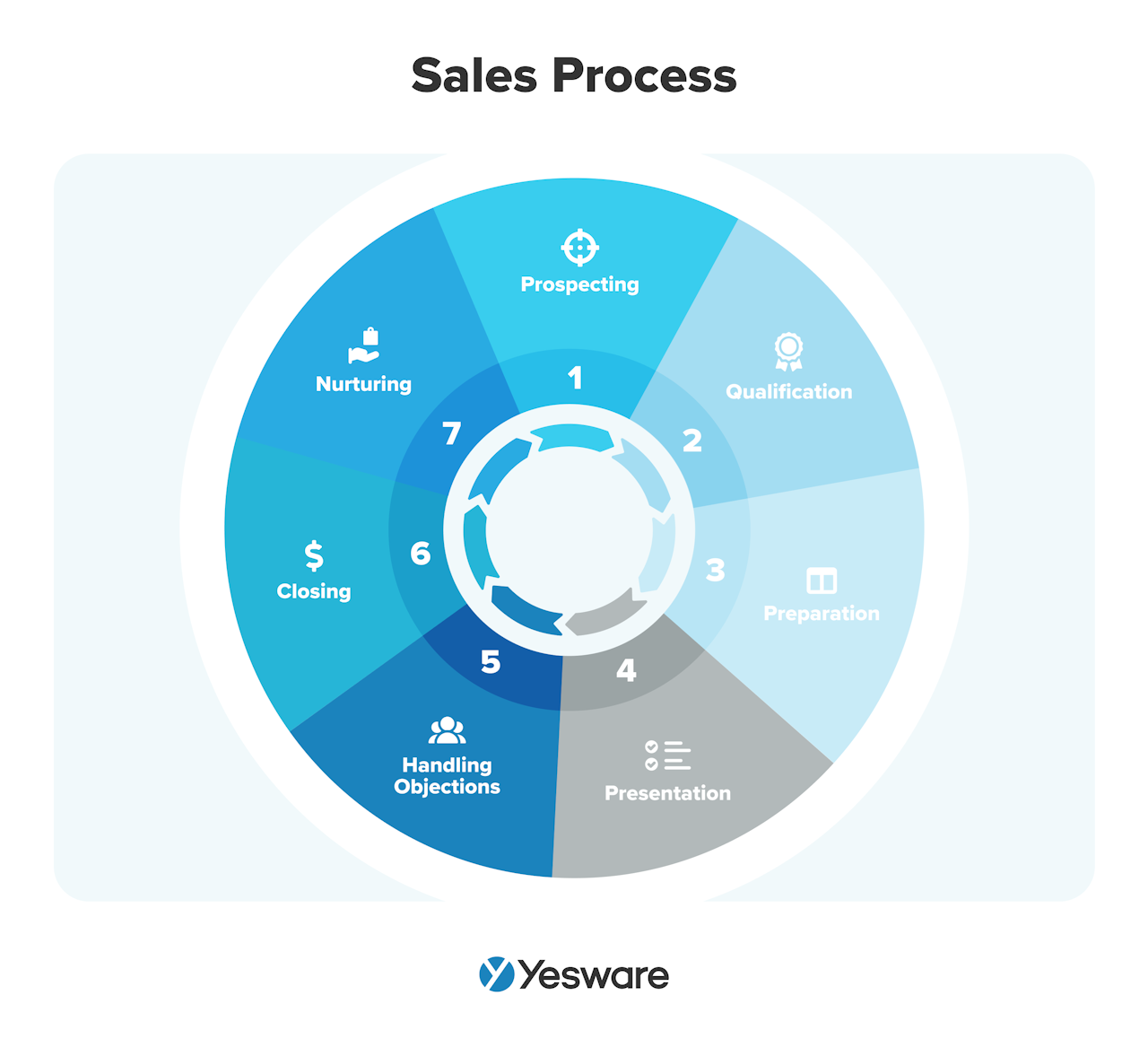 The sales process is separated into seven stages:
The sales process is separated into seven stages:
- Prospecting
- Qualification
- Preparation
- Presentation
- Handling Objections
- Closing
- Nurturing
A well-defined sales process with distinct stages helps sales reps close more deals, more easily by providing an easy-to-follow framework for what to do at each stage of the pipeline.
Having a sales process helps sales teams meet sales goals faster and with less overall effort.
Sales Process vs. Sales Methodology
Though many confuse the sales terms (and their concepts), a sales process is not the same thing as a sales methodology.
A sales process refers to the set of defined, repeatable steps that sales reps follow in order to move prospects through the sales funnel.
A sales methodology, on the other hand, refers to a sales rep’s prescribed mindset and subsequent approach to the sales process steps.
Also, a sales methodology isn’t a concrete set of steps; rather, it’s the philosophy that guides sales reps in executing the steps laid out in the sales process. 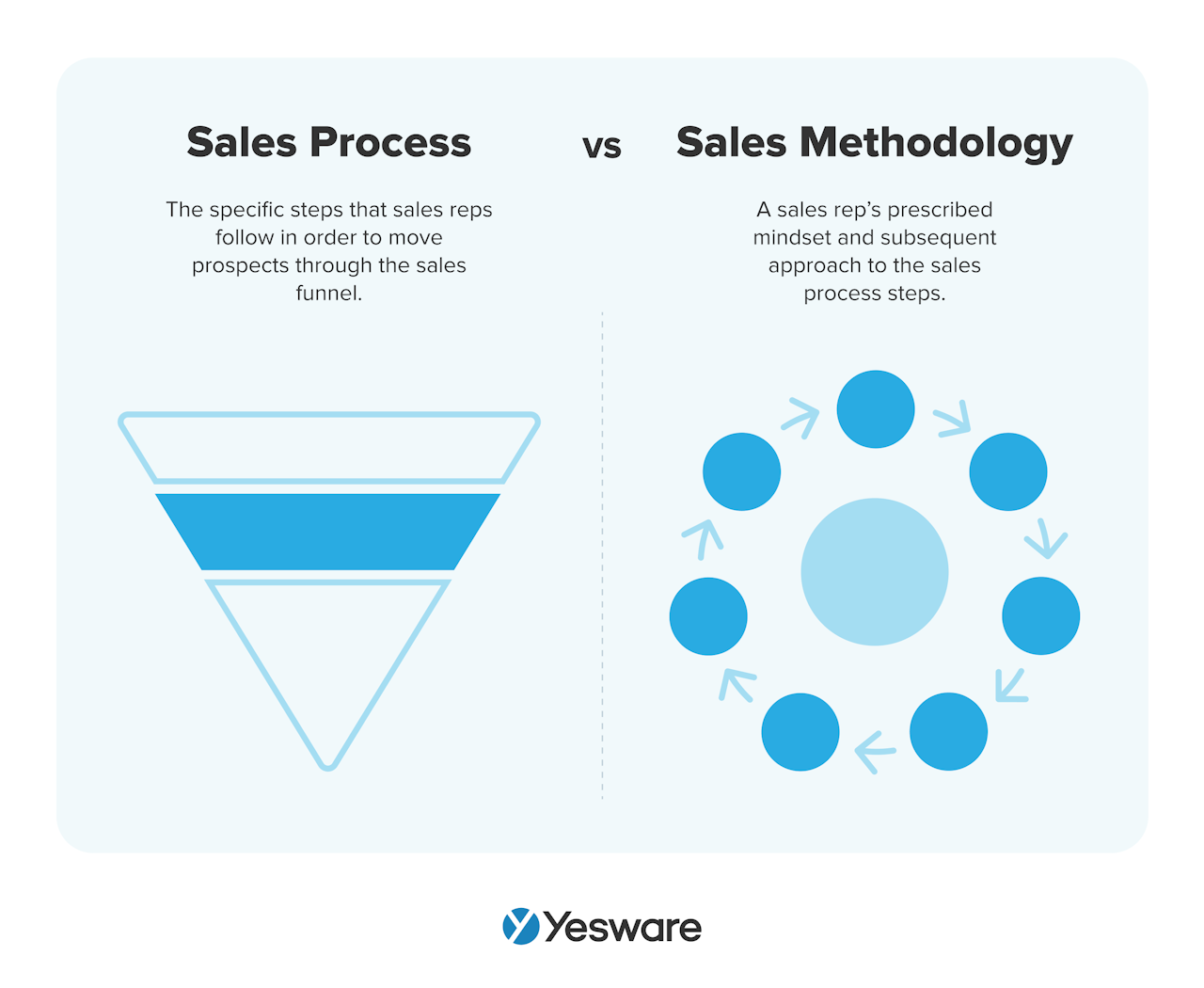 Some common sales methodologies include:
Some common sales methodologies include:
Think of the sales process as “what to do” and the sales methodology as “how to do it.”
Why Is a Sales Process Important for Your Sales Team?
A B2B sales process acts as a formal guide for sellers as they navigate the sales pipeline. It tells them exactly what to do and when, what outcomes to expect, and how to overcome common challenges.
This kind of structure is one of the strongest predictors of high performance. Research has shown that nearly 80% of all companies that use formal, guided sales processes were ranked as the highest performing.
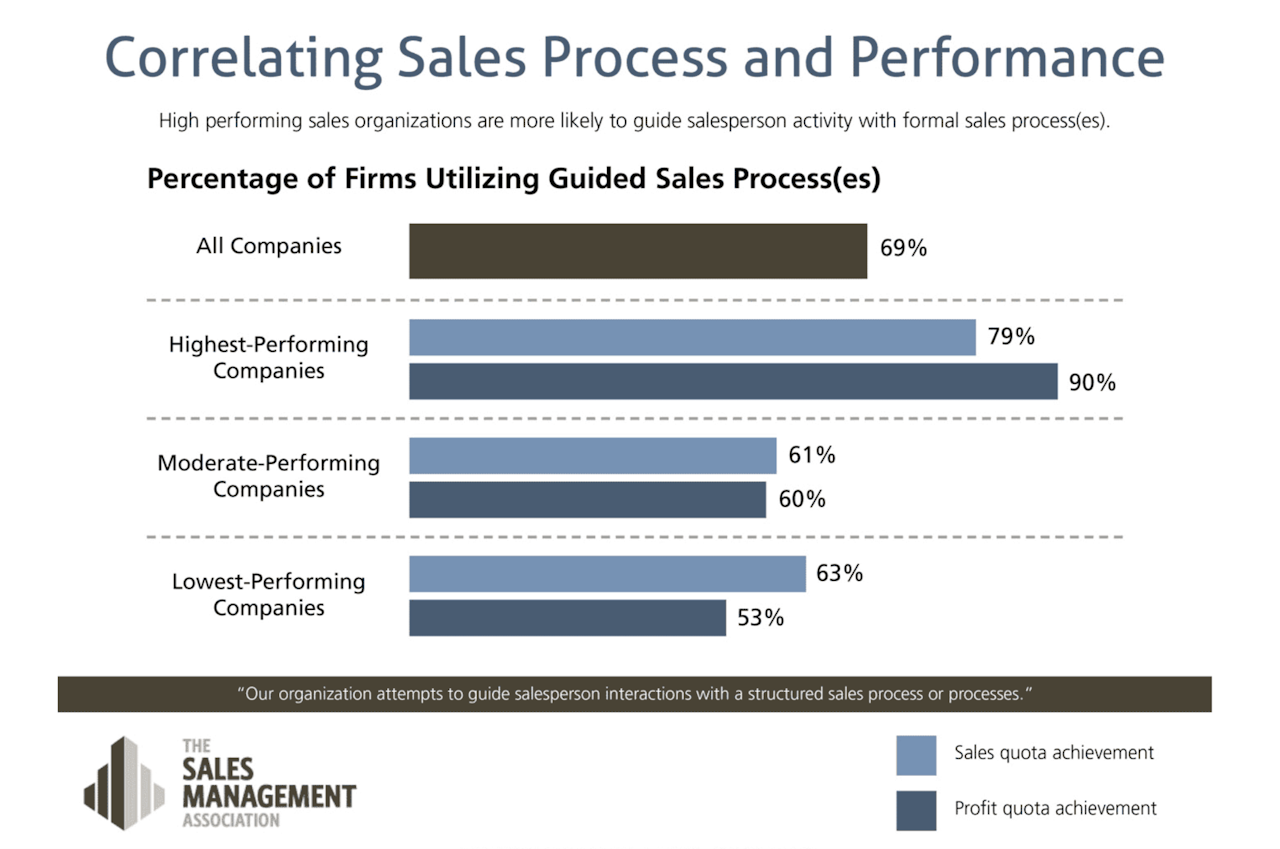
In other words, high-performing sales teams are more likely to formalize their sales process and implement a specific action plan than low-performing ones.
There’s money data to back this up, too: Harvard Business Review found that companies with a structured sales process had 28% higher revenue than those who took a more random, disorganized approach to sales.
The existence and adherence to a structured sales process benefits sales reps, sales managers, and prospects/customers alike.
Helps Sales Reps
Implementing a formal sales process has a number of benefits for sales reps of all levels of experience.
For new hires, having a sales process already in place can make onboarding simple and straightforward, and significantly cut down ramp-up time. It gives new sales reps visibility into the resources and sales activities necessary to close a deal from start to finish, and a framework for approaching prospects at various stages of the pipeline.
Structured sales processes can also be very beneficial even for experienced salespeople. A data-driven sales process can improve the lead generation process, shorten the sales cycle, and close more deals.
Helps Sales Managers
Sales processes help sales managers ensure that their team stays on track. It reduces micromanagement and allows sales managers to trust that their reps can confidently execute the necessary sales activities to close deals.
A sales process also gives sales managers insight into what goes into making a sale, so they can allocate their resources accordingly. And, when there are issues, a defined sales process can make it easy for sales managers to pinpoint bottlenecks or other challenges and easily pivot or correct them as needed.
A formal sales process can also improve the accuracy of your team’s sales forecasts, which is an important indicator for investors that you are reliable and in touch with your performance and growth.
Helps Prospects and Customers
Formalizing the sales process enables sales reps to become very familiar with the nuances, preferences, and triggers of their ideal customer profile (ICP) and buyer personas. 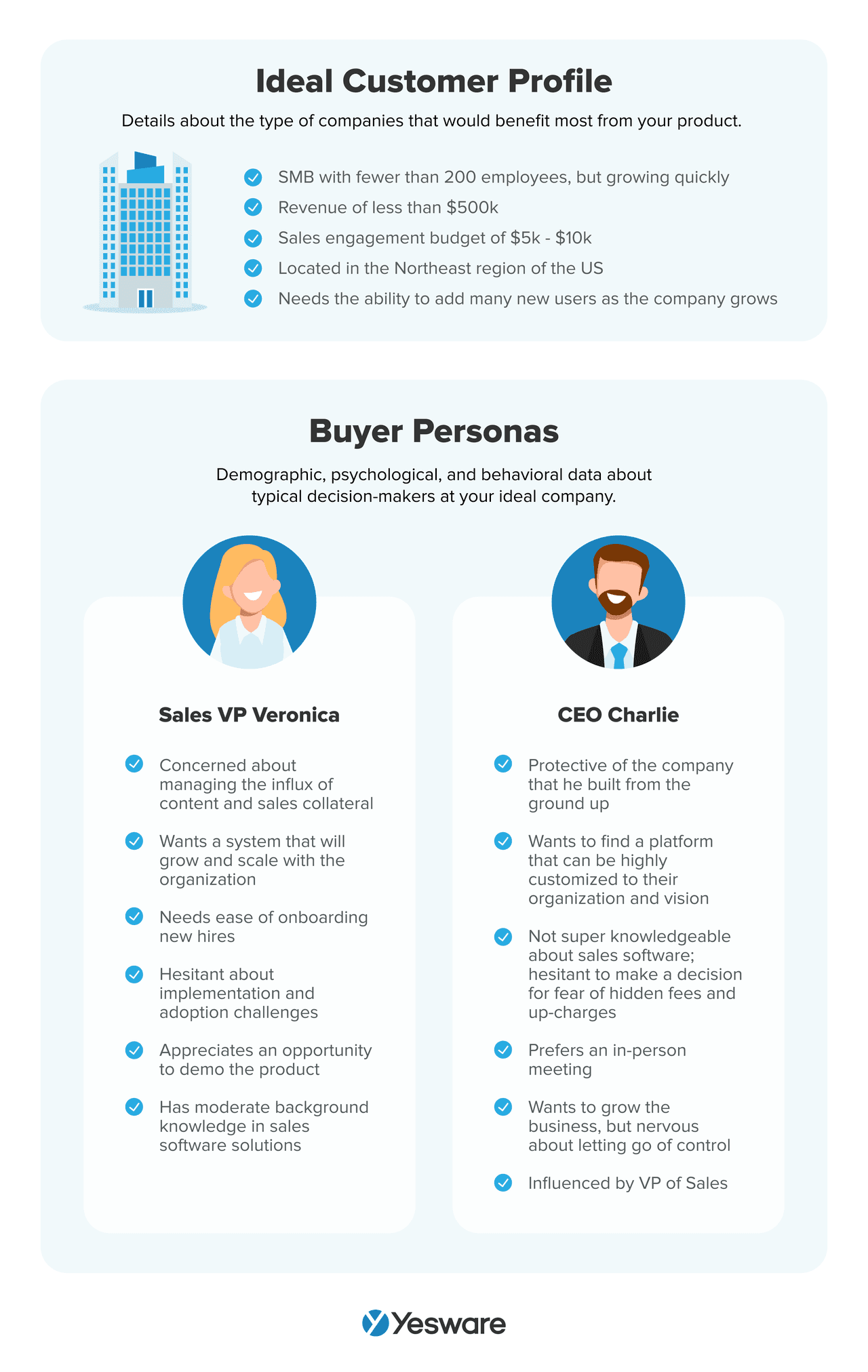 The better sales reps understand the details of each type of buyer they may encounter throughout the sales process, the more they can personalize the experience for each new prospect.
The better sales reps understand the details of each type of buyer they may encounter throughout the sales process, the more they can personalize the experience for each new prospect.
A formalized sales process also helps sales reps perfect and systemize things that work well, leading to a more consistently enjoyable buying process for the prospect.
Sales Process Steps
Following are details about the seven general steps of the sales process. The specifics of each stage will be unique to your team and buyer, but the structure and stages are more or less the same across organizations and industries.
1. Prospecting
Sales prospecting is the first stage of the B2B sales process.
During prospecting, sales reps reach out to early-stage leads to initiate conversation. They may make contact via cold calling, cold emailing, social media messaging (LinkedIn, Facebook, Twitter, Quora, etc.), or in-person networking events like conferences or trade shows. 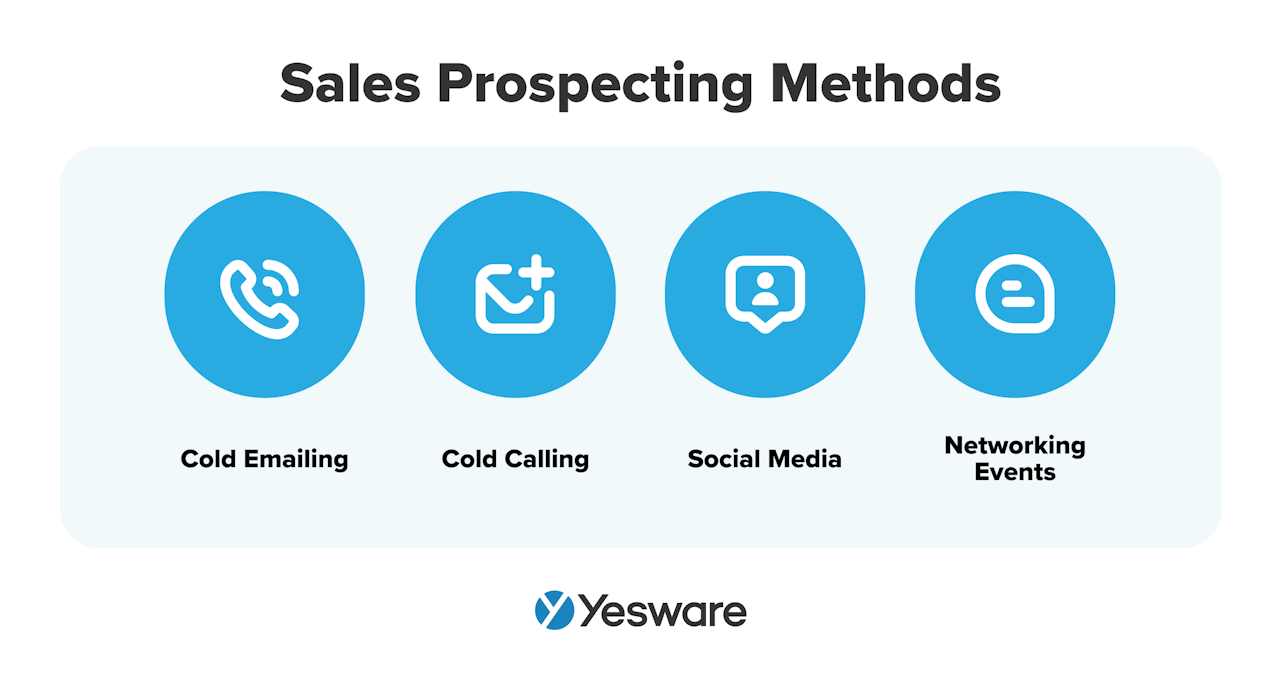 Your ideal customer profile is extremely important for the prospecting step in the sales process. If you haven’t developed these profiles yet, or if it’s been a while since your team has updated theirs, take the time to sit down with your marketing counterparts to create or update yours.
Your ideal customer profile is extremely important for the prospecting step in the sales process. If you haven’t developed these profiles yet, or if it’s been a while since your team has updated theirs, take the time to sit down with your marketing counterparts to create or update yours.
If you’re not sure where to start, try identifying characteristics shared by your current highly satisfied clients. This will help you develop the specifics of your best-fit customer.
2. Qualification
Next, lead qualification. Leads that come in need to be qualified before they can move further along in the sales process.
“Qualifying a lead” means determining how good of a fit a lead is for your business (or, in some cases, whether they’re a fit at all).
There are many different frameworks that sales reps can use to help them qualify prospects. Methods like BANT (Budget, Authority, Need, Timeline), CHAMP (Challenges, Authority, Money, Priority), and MEDDIC (Metrics, Economic Buyer, Decision Criteria, Decision Process, Identify Pain, and Champion). 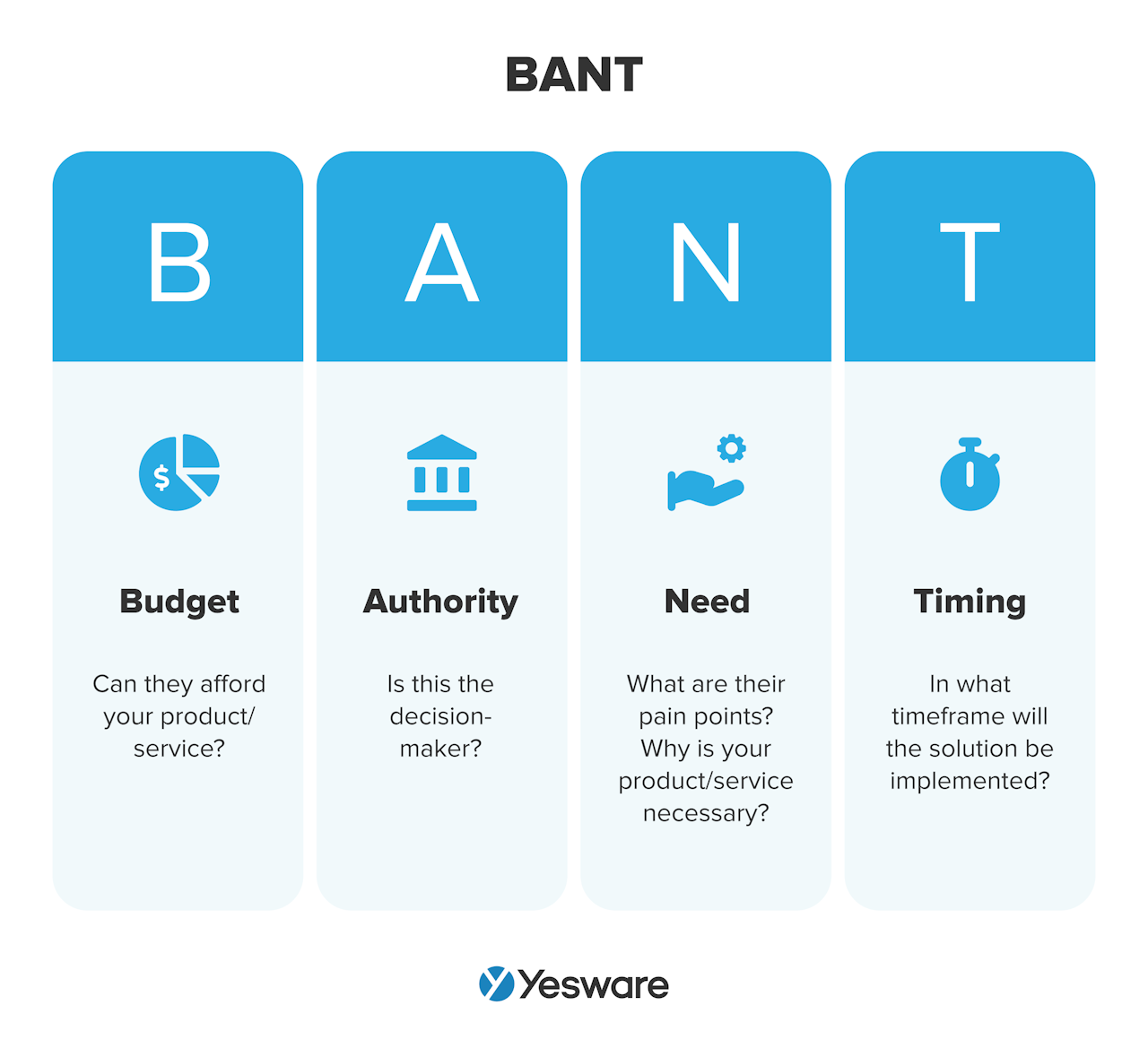 Some sales teams choose to use lead scoring to help with the lead qualification process.
Some sales teams choose to use lead scoring to help with the lead qualification process. 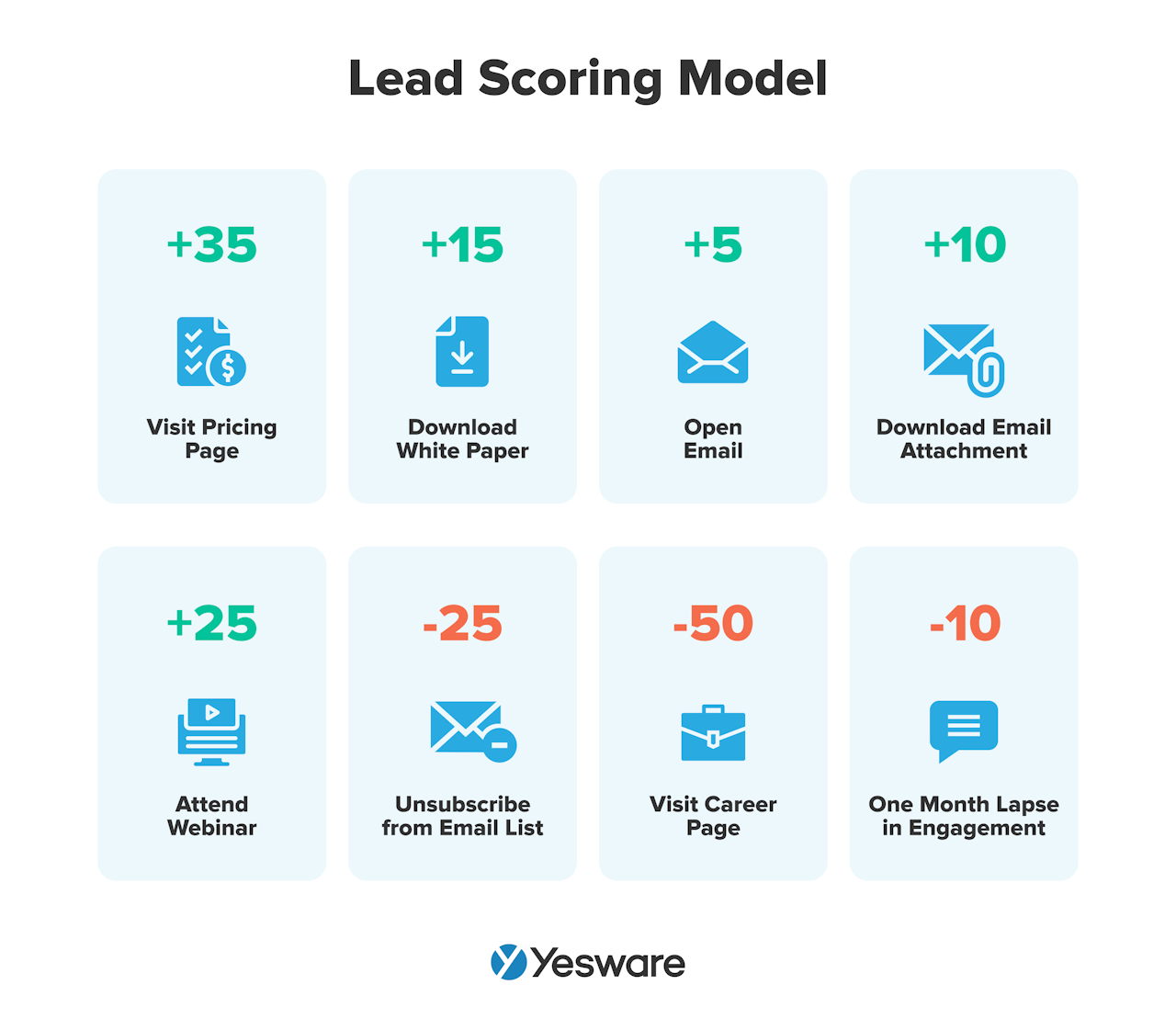 The following questions can also give you a starting point for the kinds of questions that can help qualify leads:
The following questions can also give you a starting point for the kinds of questions that can help qualify leads:
- What is your role at your company?
- What are your job duties and responsibilities?
- What problem are you/your team trying to solve? How does it impact you directly?
- How much of a priority is solving this problem for your business?
- What other solutions are you considering?
It’s extremely important for salespeople to effectively qualify the leads that enter the pipeline. If the lead qualification process is subpar, sales reps risk wasting their precious sales time on poor-fit leads.
And with only about a third of a sales rep’s time afforded to actual selling activities, they can’t afford to waste it on prospects who were never going to purchase in the first place but somehow slipped through the funnel.
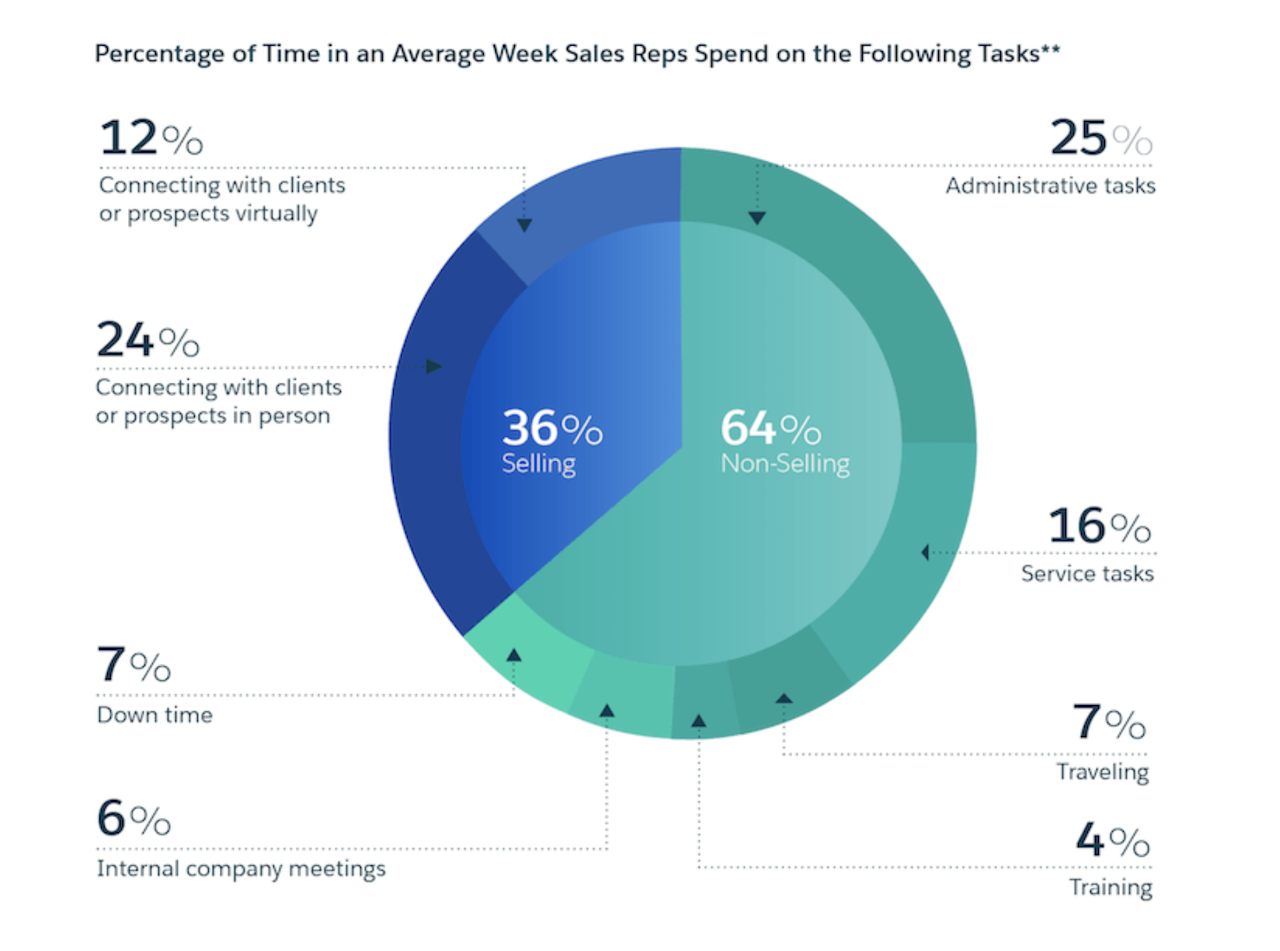
3. Preparation
After you qualify prospects to determine which are worth moving to the next stage of the sales funnel, it’s time to dig into heavy research.
Your ICP and buyer personas are helpful, but are intended to be a generic template to help you find general good matches. As you begin to approach individual buyers at real companies, you need to make sure you know specifics about their challenges, their needs, and the inner workings of their organization.
The more you understand about each individual prospect and their company, the better position you’ll be in to present yourself as the ideal solution.
Buyers today expect deep personalization throughout the sales process (and some even abandon purchasing decisions when they feel the conversation isn’t personalized to their unique circumstances), so make sure you have a complete understanding of their unique needs before you dig into your pitch.

4. Presentation
The presentation stage of the sales process is reserved for highly qualified prospects that represent a good chance of converting to a sale.
The sales presentation or demo is a sales rep’s opportunity to show off the more technical aspects of their offer and tangibly communicate the unique selling propositions (USP) that will bring value to the buyer.
Again, this step requires heavy personalization. Try to anticipate what kinds of questions or needs a particular buyer will raise during the demo, and go out of your way to work them into your presentation. It’s important to walk the line to avoid being pushy, but you also want to demonstrate that you’re willing, able, and eager to meet their unique needs.
5. Handling Objections
Although some inexperienced sales reps conflate them with failure, sales objections are a normal and expected part of the sales process.
Sellers should expect to encounter sales objections in just about every sales conversation and have persuasive answers rehearsed accordingly. 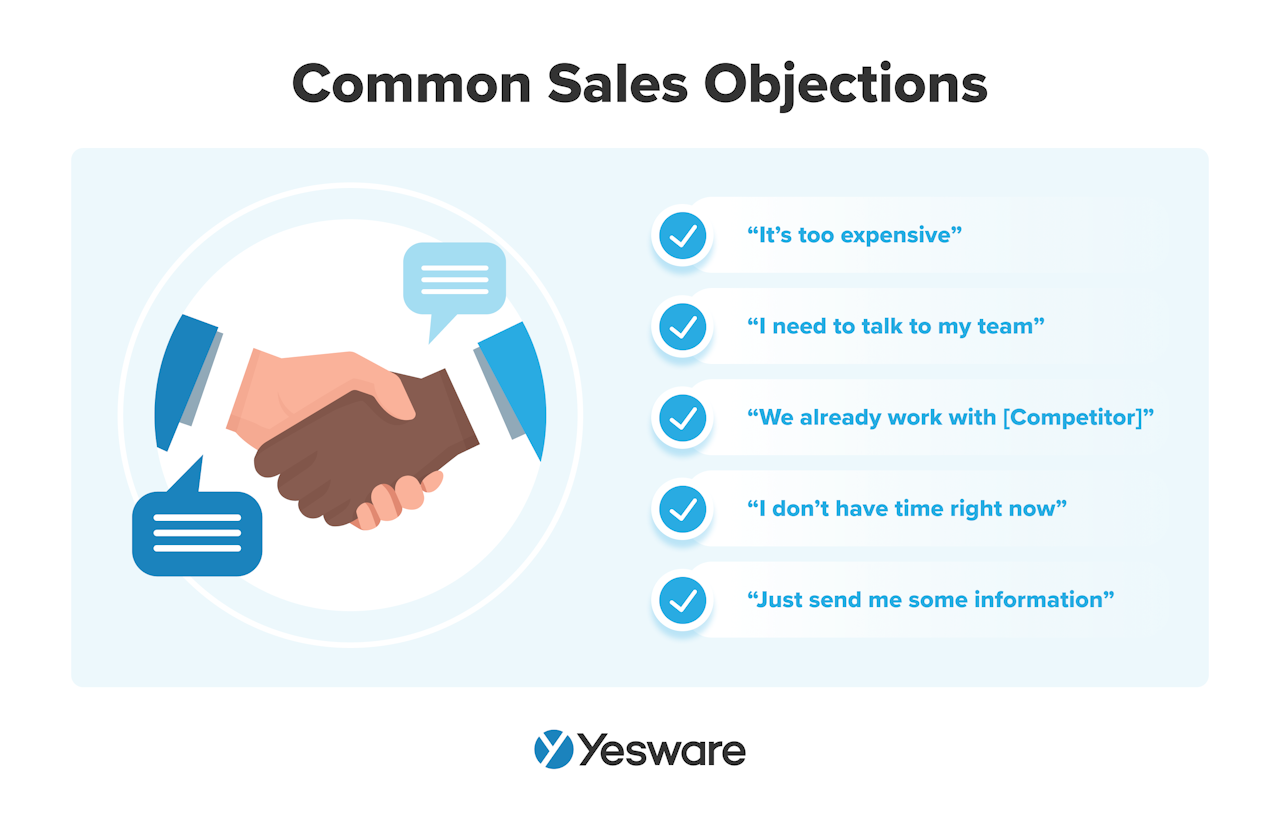 With that in mind, sales reps will be well-served to reframe their thinking around sales objections. Rather than viewing them as roadblocks, reps can look forward to sales objections as opportunities to learn more about a prospect’s needs, and leverage to position their product as the ideal solution.
With that in mind, sales reps will be well-served to reframe their thinking around sales objections. Rather than viewing them as roadblocks, reps can look forward to sales objections as opportunities to learn more about a prospect’s needs, and leverage to position their product as the ideal solution.
6. Closing
Fortunately, most of the hard parts of the sales cycle are over by the time sales reps reach the closing stage.
In this stage, prospects may have verbally committed to purchase. Here, sales reps are responsible for providing and/or negotiating quotes and proposals.
Remember as you close that a purchase represents a new partnership. It’s exciting to land a new deal, but the success isn’t all about your quota. Make sure you’re prepared to give your new customer an outstanding onboarding experience and work with customer success to ensure their experience is smooth.
7. Nurturing
Every salesperson knows the unfortunate truth that not every prospect that moves through the funnel represents a closed deal.
Some will leak out of the funnel because they were poor fits to begin with, but others may be a good match for your product but need more time.
This is where nurturing comes in.
Sales reps and marketers should design a specific subsection of the sales process specifically for well-matched prospects who need more time (with or without a sales rep’s assistance) before they buy. They can then re-target this group with passive but persuasive content until they’re ready to move forward.
Content marketing and email sequences can be extremely effective in nurturing prospects until they’re ready to commit.
The nurturing stage can also look like generating customer referrals and cross-selling and upselling existing customers. 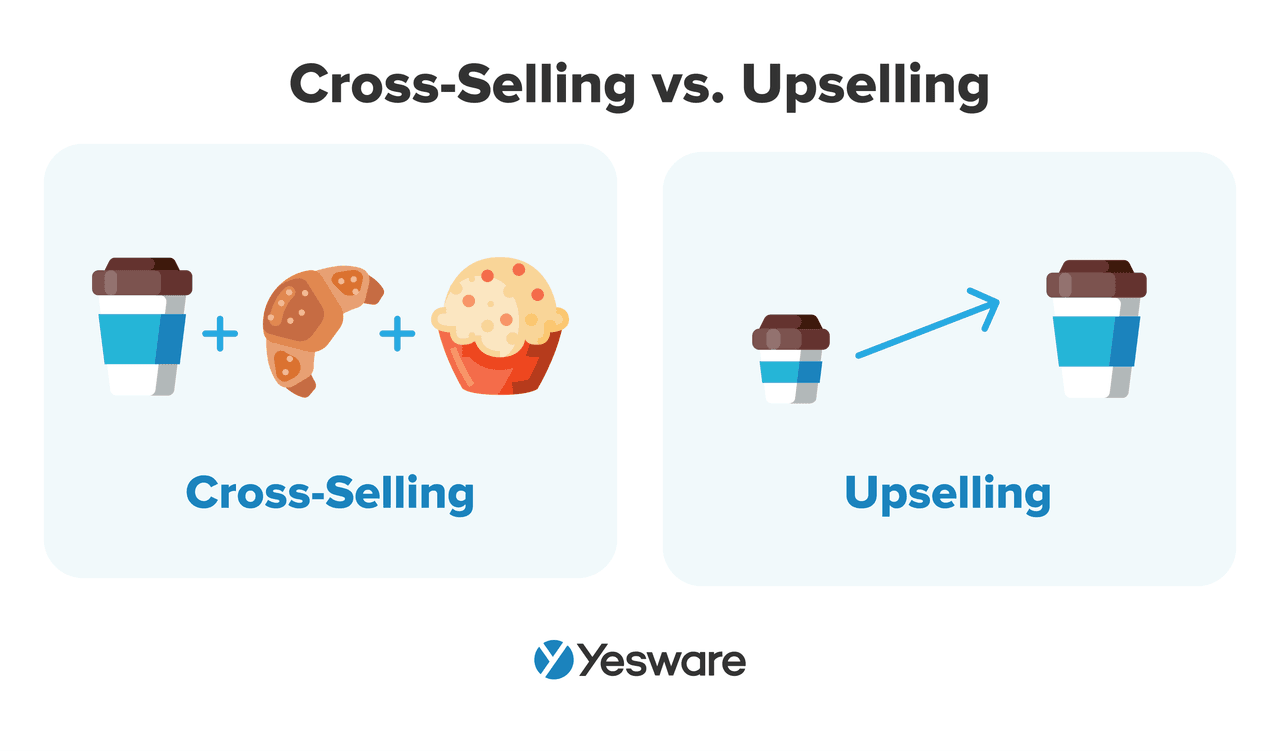 Tip: Looking to improve your sales process? We analyzed hundreds of millions of sales activities to identify data-backed best practices for sales teams.
Tip: Looking to improve your sales process? We analyzed hundreds of millions of sales activities to identify data-backed best practices for sales teams.
 Sales Engagement Data Trends from 3+ Million Sales ActivitiesLooking at millions of tracked email activity over the past few years, this ebook is filled with our top studies and findings to help sales teams accelerate results.
Sales Engagement Data Trends from 3+ Million Sales ActivitiesLooking at millions of tracked email activity over the past few years, this ebook is filled with our top studies and findings to help sales teams accelerate results.
How to Build a Strong Sales Process
For teams hoping to create or improve their sales process, the following steps will help you get started.
Keep in mind that the sales process should be detailed and specific. The steps outlined here are generic and somewhat vague for a reason — so that they can apply to many different types of business.
It’s up to the collaborative efforts of your sales and marketing teams to personalize this process and inject the relevant details that make it a sales document that’s relevant and valuable to your unique organization.
1. Reverse Engineer the Process
It may seem counterintuitive, but the best way to begin mapping your sales process is to start at the end. You can’t figure out how to get where you’re going until you know exactly where you want to end up.
Begin creating your sales process by getting clear on your sales goals. The SMART goal framework can help guide your goal-setting process in a way that invites action and generates motivation. 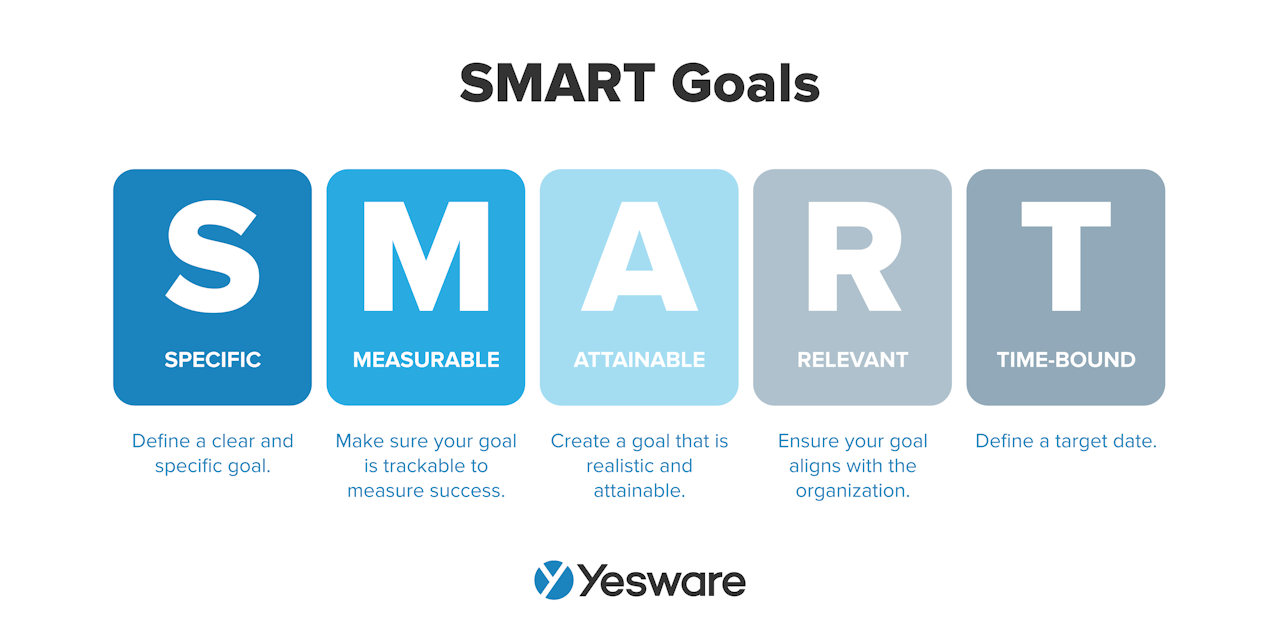
2. Align Your Teams
Though it’s called the “sales” process, the reality is that this framework is best designed collaboratively.
Sales and marketing alignment is crucial for sales and organizational success (as shown below). 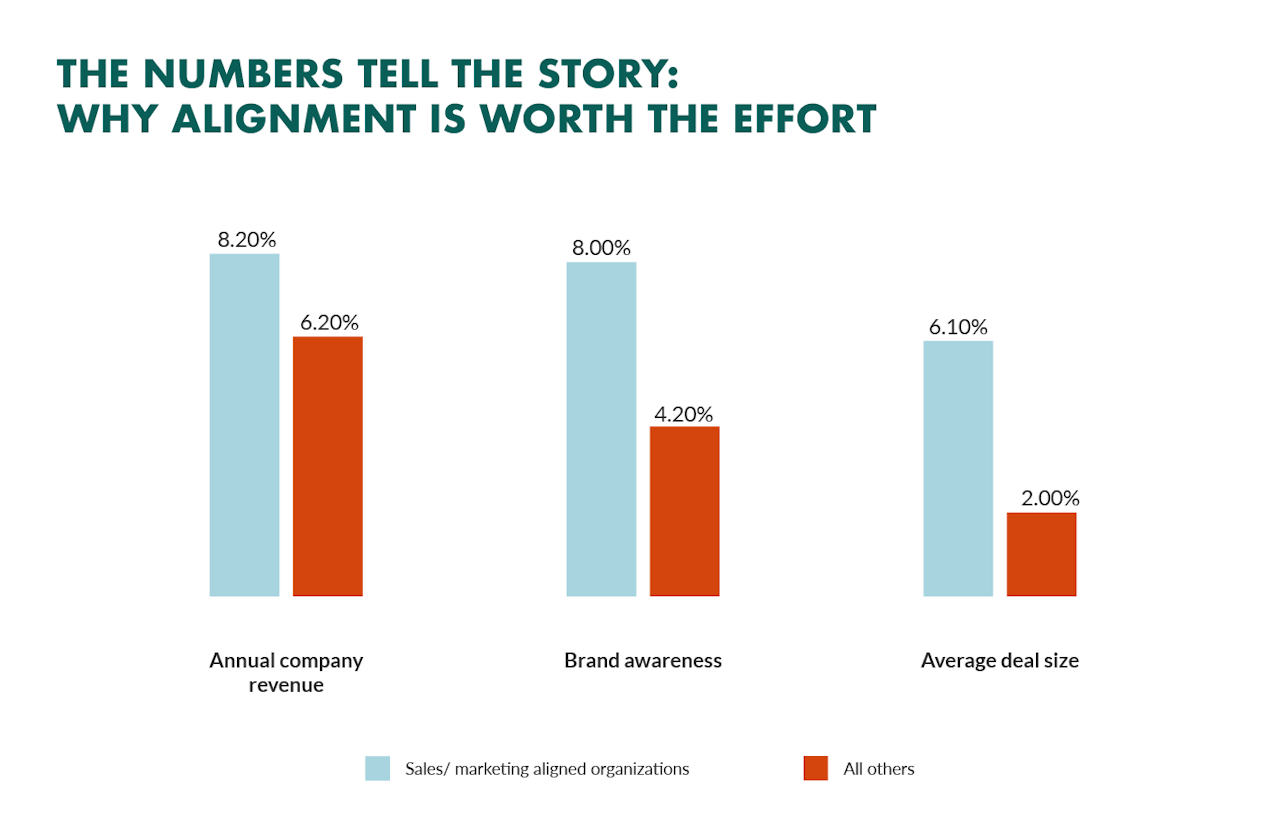 Although sales and marketing are the two most critical contributors, designing the sales process can also be benefited by the attendance of customer success, and sometimes even product development, finance, and/or IT.
Although sales and marketing are the two most critical contributors, designing the sales process can also be benefited by the attendance of customer success, and sometimes even product development, finance, and/or IT.
3. Map the Buyer’s Journey
Although it’s sales reps who rely on the sales process in their day-to-day jobs, the best ones are designed with the customer in mind.
Sales processes should be built for sales reps, but from the perspective of the buyer.
Your ICP and buyer personas will guide you as you map out the activities, decision points, and outcomes of your desired sales process in a way that speaks directly to the needs of your buyer.
Current satisfied customers can be a wealth of information when it comes to learning more about the buying process from the prospect’s perspective.
4. Outline the Sales Process Steps
With all of your due diligence complete, it’s finally time to put pen to paper and outline the actual steps of your sales process.
Here, you’ll detail every step, decision point, strategy, tactic, and more that goes into closing a deal, from early stage lead to closed-won.
In this step, it’s a good idea to define specific entry and exit actions for each stage of the process.
For example, you’ll want to define what specific actions move a prospect from the “Preparation” stage to the “Presentation” stage: What exact information does a sales rep need before moving forward? How many contacts should a sales rep make with a prospect before presenting?
In other words, what specific actions or behaviors specify that a given stage is beginning and/or ending?
This step, like all others in the process, should be a collaborative one. Seek input from your sales and marketing teams about what works well for them in the sales process, and what challenges they envision. Design the sales process with their strengths in mind, and actively solicit their feedback as you create it.
5. Implement, Measure, and Optimize
Creating a sales process is never a one-and-done process. Sales teams need to carefully track their sales metrics and analyze them regularly in order to improve the process.
It’s normal to develop several iterations of your sales process over time as you learn what works and doesn’t work for your sales reps — and, more importantly, your buyer.
How to Measure the Success of Your Sales Process
The following metrics can shed light on how effectively your current sales process resonates with your target market and/or your sales team.
- Lead to opportunity conversion: A lead becomes an opportunity once they’re qualified and have shown interest/potential in making a purchase. The lead to opportunity conversion rate can indicate the effectiveness of your outreach, lead qualification, and/or presentation strategies.
- Overall conversion rate: Your team’s overall conversion rate is a good big-picture indicator of the effectiveness of your sales process from start to finish.
- Average length of the sales cycle: Although sales cycle lengths vary by industry, buyer need, and complexity of sale, the general rule of thumb is that shorter sales cycles are better. The more appropriate sales cycle optimization might be described as “only as long as it needs to be.”
- Individual sales quota attainment: Tracking your sales reps’ individual quota attainment can help identify reps that may need additional training or coaching.
- Process adoption: A birds-eye view of how many of your team members follow your sales process (as well as how faithfully they’re able to do so) can give you a good idea about how accessible it is. Sales processes that are too complex or unrealistic are uninviting for sales reps, and you’re likely to encounter low adoption rates with these kinds of initiatives.
- Accuracy of sales forecasts: If you find that your sales forecasts are consistently off, it’s likely that at least one aspect of your sales process is askew.
These are just a few ideas. Remember, the specifics of your sales process will ultimately be defined by your organization’s unique goals. With that in mind, focus on tracking the metrics that have the most impact on your current sales goals.
How to Improve Your Sales Process
If you already have a sales process in place, but are hoping to improve it, the following action steps will help you see tangible results.
Analyze Your Current Sales Process
In order to improve your sales process, you need to have a deep understanding of how it currently works.
Spend time (at least one or two sales cycles) looking at the sales process from all angles: How do your reps use their time? What are each of their strengths? How do they work together collectively? How do they leverage and store sales data throughout the sales process? How long does each stage take? How many prospects are disqualified early? How many follow-ups does the average prospect require?
The list of questions is virtually endless, but the work is nonetheless important. You can’t improve something if you don’t know what, exactly, needs improving.
Learn as much as you can about what makes deals close, what makes sales reps succeed, and what gets most in the way of those things.
Outline the Buyer’s Journey for Your Target Persona
Remember: the sales process needs to be customer-centric. Many mediocre sales processes would see drastic improvement if they approached it from more of the customer’s perspective.
Your sales and marketing teams should sit down together and look carefully at the specifics of your buyer’s journey. 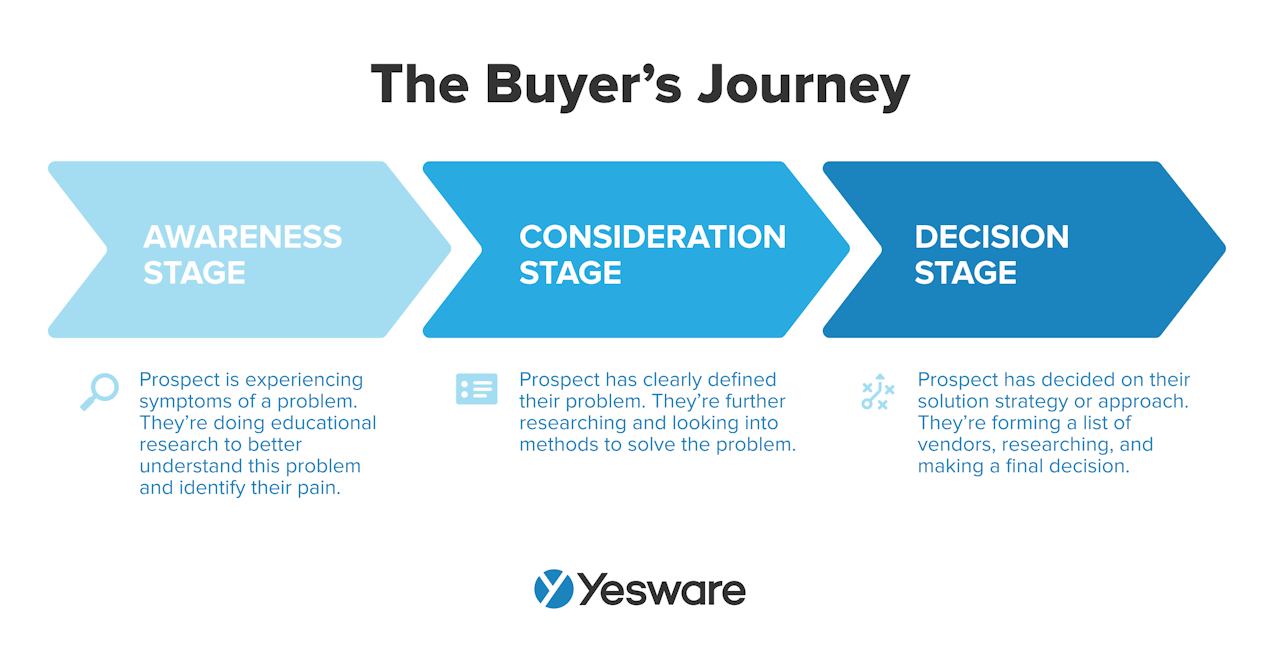 The more familiar you are with their experience and their pain points throughout the process, the more you can tailor the sales process to their needs.
The more familiar you are with their experience and their pain points throughout the process, the more you can tailor the sales process to their needs.
Get Specific
Many sales managers find through the process of optimization that the first iterations of their sales process lacked adequate detail.
Sales processes should be easy to understand, but don’t confuse straightforwardness with generality. The sales process outline needs to contain specific criteria — behaviors, actions, questions, data, etc. — assigned to each stage, as well as pinpoint unique inflection points that serve as transitions between stages.
Not only does this level of detail help your sales reps stick to the plan, it also helps improve the process as you optimize it. When sales reps can identify specific triggers they use in sales conversation that motivate prospects to take the next step, they can replicate that in sales scripts for future opportunities.
Measure Your Sales Process Results
Creating a sales process is all but useless if you don’t track its results and use them to improve. Make sure you take the time to track the leading and lagging indicators within your sales process. 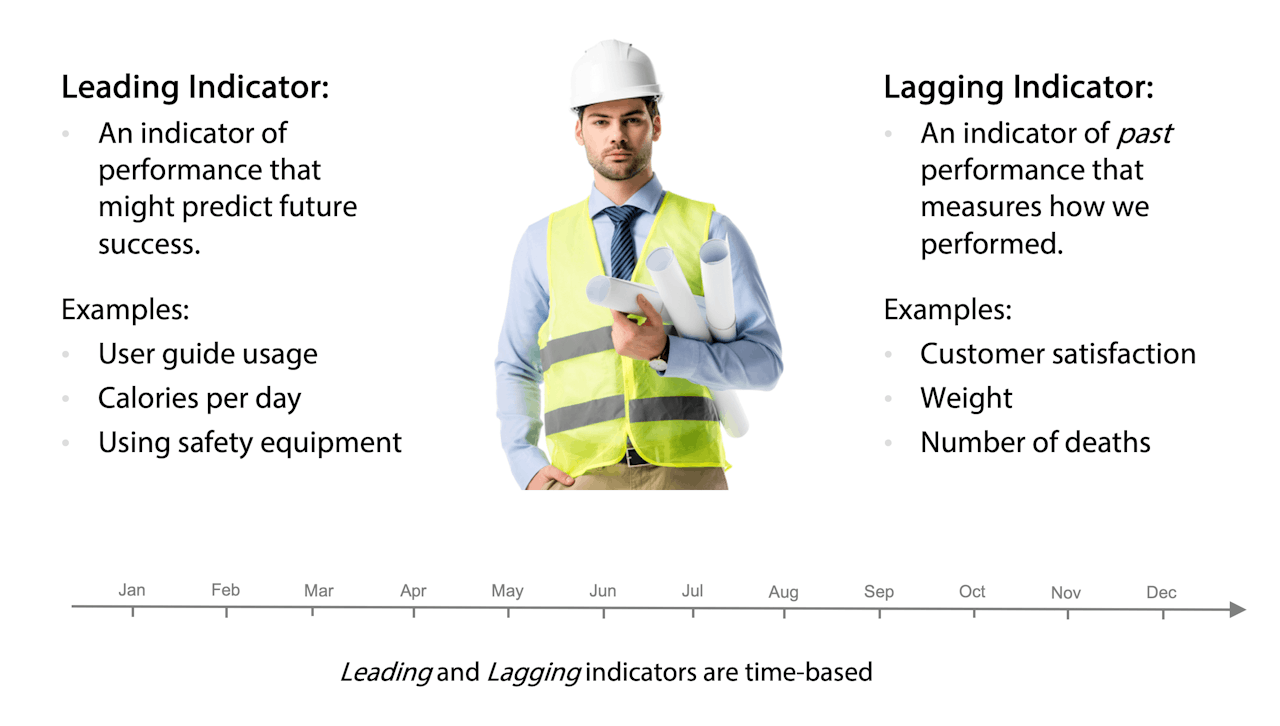 To extend the image above with a sales example, a leading indicator might be something like “number of cold calls” or “number of demos scheduled,” while lagging indicators are metrics like “number of deals closed” or “number of leads converted to opportunities.”
To extend the image above with a sales example, a leading indicator might be something like “number of cold calls” or “number of demos scheduled,” while lagging indicators are metrics like “number of deals closed” or “number of leads converted to opportunities.”
You won’t ever know what works and what doesn’t if you don’t keep careful track of what you’re doing, so take the time to log your actions and their results. And be transparent — bad data is sometimes worse than no data at all.
Sales Enablement & Sales Engagement
One of the easiest and often most effective ways to improve the sales process is by equipping the sales team with sales enablement and sales engagement resources.
Your sales process may be perfect on paper, but it won’t matter if your sales reps don’t have the tools and resources needed to implement it.
Common Sales Process Mistakes to Avoid
It can be easy to become complacent when it comes to sales processes. Be mindful of the following all-too-easy-to-make mistakes that can destroy the effectiveness of a sales process before it ever has a chance to generate results.
1. Leaving Things Open to Interpretation
This may sound repetitive, but it’s worth repeating: an effective sales process is a specific and tangible one. The sales process is not the place to be vague or intentionally ambiguous. It needs specific, concrete actions that clearly show how sales reps need to guide prospects through the stages.
To that end, it’s a similar mistake to leave your data-collection practices open to interpretation. Everyone has different standards for note-taking and number-tracking, so make sure you clearly define who needs to track what, and where it needs to be stored. The more transparent this storage can be, the better; mutual accountability is highly motivating.
2. Relying on a Single Sales Methodology
No single sales methodology is meant to be the be-all, end-all for your sales process. Most buyers appreciate (sometimes even subconsciously) a combination of more than one approach to sales, and sales reps who are well-versed in several are more likely to reach more prospects.
3. Excluding Marketing
It’s standard practice now for sales and marketing teams to work closely alongside one another, but some teams forget that this collaboration should include the creation of the sales process.
Although sales reps are the ones responsible for executing the sales process, marketing needs to have equal input in its creation because they design the campaigns that attract the target buyer.
4. Focusing on Quota
Creating and optimizing a sales process is a data-driven endeavor, but don’t allow that to let you lose sight of the bigger picture in sales: value first.
Don’t allow the focus on data, tracking, and goal-setting to blur the idea that the prospect’s needs are a by-product of the process.
In fact, the reality is the opposite: if the process is going to be effective, it needs to revolve around delivering value to the customer. Value-driven organizations are more likely to grow revenue, have higher win rates, and have lower rep turnover (among other benefits).
5. Neglecting the Follow-up
Most sales happen after the fourth follow-up, but most sales reps leave prospects alone after only one rejection. 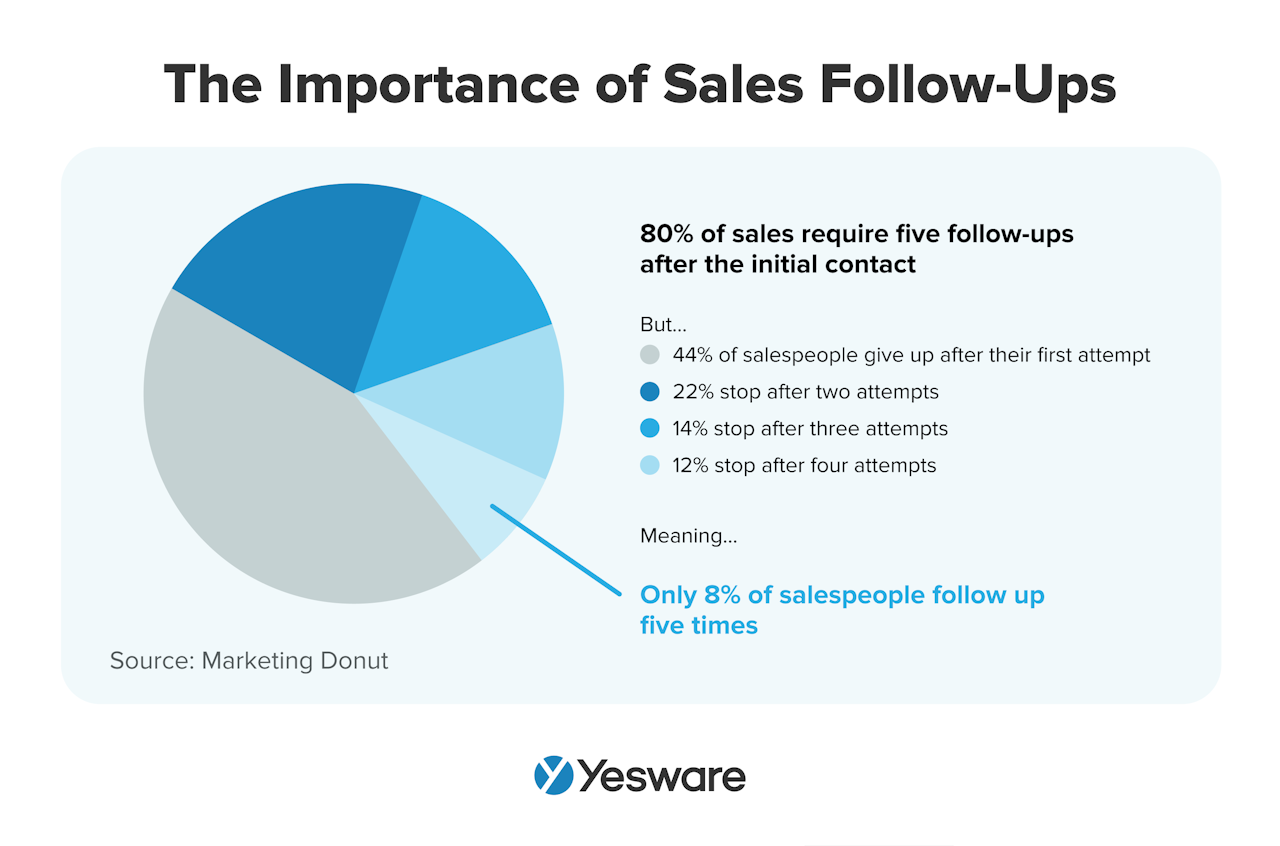 Sales reps who know how to work the sales process know that follow-ups are a normal part of it. They plan their follow-ups strategically and leverage technology like Yesware to help them stay on top of scheduling them.
Sales reps who know how to work the sales process know that follow-ups are a normal part of it. They plan their follow-ups strategically and leverage technology like Yesware to help them stay on top of scheduling them.
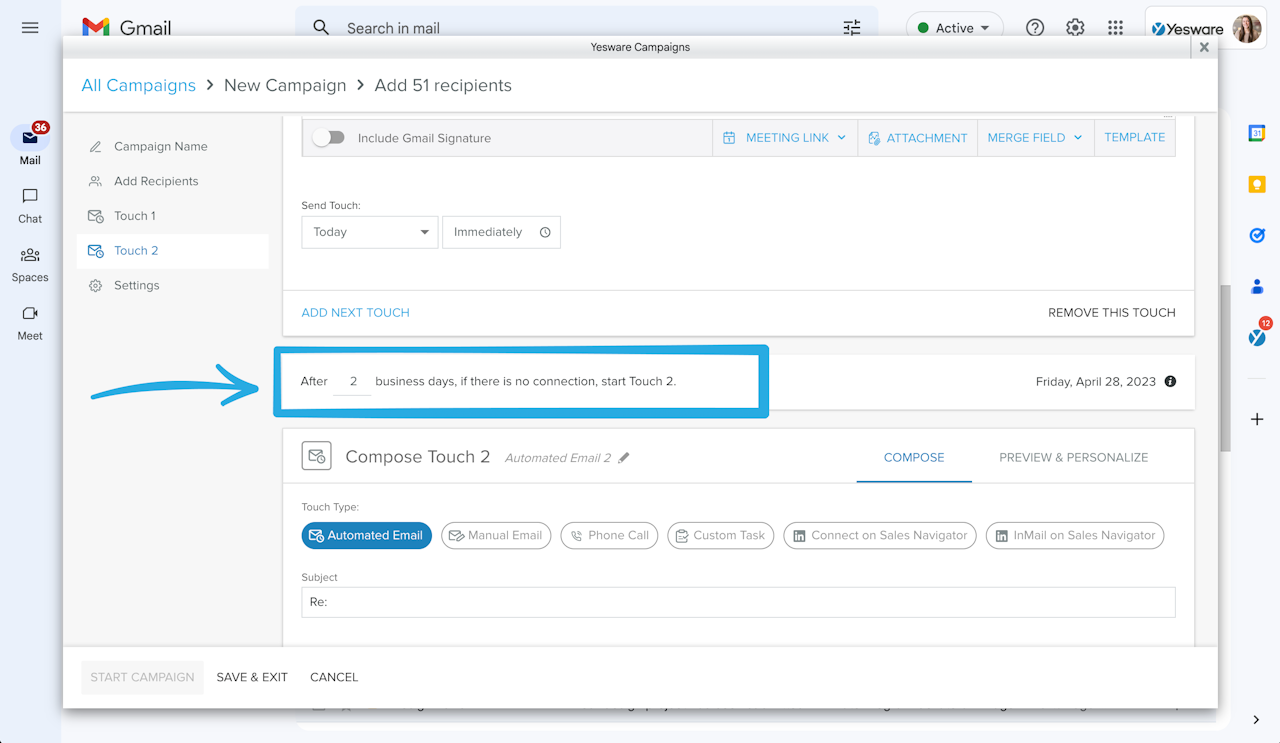
How does your sales process currently work? When was the last time you solicited feedback on your sales process from your sales team? What improvements can you make to your sales process this year?
Get sales tips and strategies delivered straight to your inbox.
Yesware will help you generate more sales right from your inbox. Try our Outlook add-on or Gmail Chrome extension for free, forever!
Related Articles
Casey O'Connor
Casey O'Connor
Anya Vitko
Sales, deal management, and communication tips for your inbox

